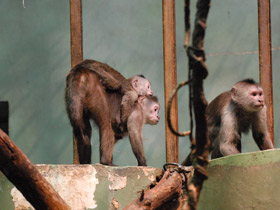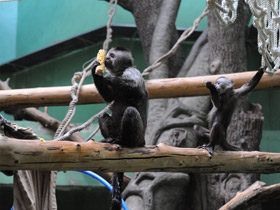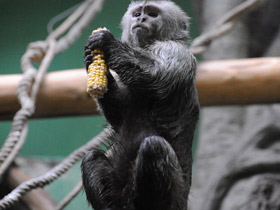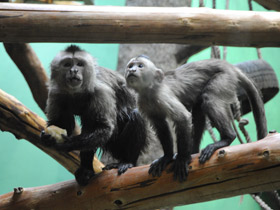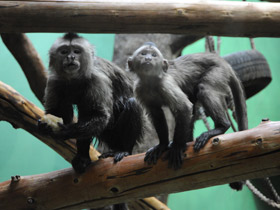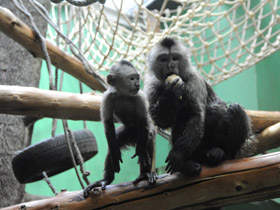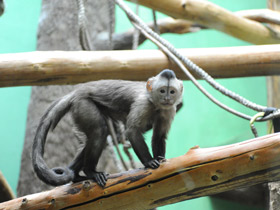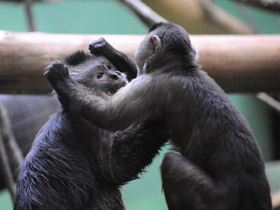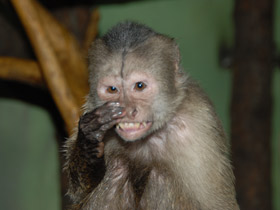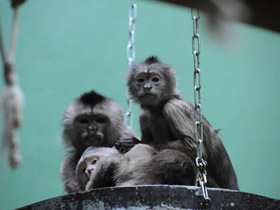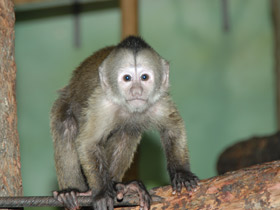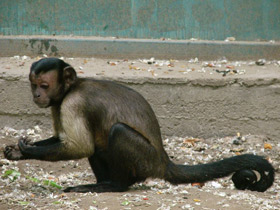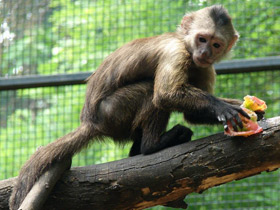The wedge-capped capuchin or Guianan weeper capuchin (Cebus olivaceus)
Taxonomy
The genus Cebus is divided into several different species. However, taxonomists argue over the specific divisions within the genus, which are uncertain and controversial. The chestnut capuchin (Cebus castaneus) of northeastern Brazil, southern Guyana, French Guiana, and Suriname, as well as the brown weeper capuchin (Cebus brunneus) of northern Venezuela, were both previously considered subspecies of the wedge-capped capuchin, together being referred to as the weeper capuchin. However, a 2012 study found grounds to separate them as distinct species from one another, although this taxonomy is still highly contentious. The American Society of Mammalogists, IUCN Red List, and ITIS all follow this taxonomy, although only tentatively.
Size and physical description
Adult wedge-capped capuchins weigh approximately 3 kg, but weight varies moderately with sex. They receive their name from a black triangle of dark fur centered on their foreheads. Generally this species is light brown to brown with yellow and gray tinges on varying parts of their bodies. Their “wedge cap” starts between the eyes and extends backwards to cover the top of the head. Their faces are hairless and surrounded by light brown or blonde fur.
Wedge-capped capuchins show similar levels of sexual dimorphism as other capuchin monkeys. On average, males weigh about 30% more than females. Additionally, males have relatively longer canines than females (even after overall body size is accounted for). Male maxillary and mandibular (upper and lower) canines of males are on average 70% and 40% larger than female canines respectively. This may be indicative of male competition for females.
Locomotion and morphology
Wedge-capped capuchins have been compared to tufted capuchins to discern the relationship between locomotion and skeletal proportions. Wedge-capped capuchins spent relatively more time running and jumping through the forest canopy while tufted capuchins spent more time walking and moving slowly. As such, wedge-capped capuchins have relatively longer limbs (particularly the hind limbs) than tufted capuchins.
Phylogeny
Due to large physical variations in Cebus, taxonomists have frequently debated the exact classifications and details of the genus. However, most agree that the wedge-capped capuchin shares the genus with four others: Cebus apella, Cebus albifrons, Cebus capucinus, and Cebus kaapori. The wedge-capped capuchin has a diploid chromosome number of 52, though some others in the genus have 54 chromosomes. Nine human chromosomes correspond to those of the Cebus olivaceus. Phylogenetic analysis and constructions of cladograms have demonstrated that the wedge-capped capuchin is closely related to Cebus apella.
Habitat and nutritional
The wedge-capped capuchin or Guianan weeper capuchin (Cebus olivaceus) is a species of neotropical primate. Cebus olivaceus is found in several South American countries: Brazil, Guyana, French Guiana, Suriname, Venezuela and possibly Colombia. It is named for its plaintive and "whining" cries. Cebus olivaceus feeds mainly on ripe fruit (55% of its diet), but also eats various invertebrates: molluscs, wasps, grasshoppers, caterpillars, ants, millipedes, spiders, as well as tree frogs, lizards and bird eggs.
Social behaviour and reproduction
These monkeys spend a lot of time on the ground and usually keep groups of 5 to 30 animals, with several females per male. Pregnancy of these monkeys lasts about 180 days, and a young is usually born. For the first three months, the mother takes care of the young, but later other members of the group begin to actively help her, to the point where the baby spends more time with the "nannies" than with the mother. The males also play with the calves quite often.
Interaction with other species
Wedge-capped capuchins sometimes rub themselves with millipedes they find while foraging. The monkeys rub the millipede against their fur, sometimes for as long as two minutes at a time. They also occasionally put the millipede in their mouths, remove them, and continue to rub them over their bodies. These capuchins often share these millipedes. The purpose of this strange behavior is difficult to determine. One theory is that the millipede, when threatened, releases noxious chemicals as a defense mechanism. These chemicals may act as insect repellants against mosquitos. This behavior is most common during the rainy season, when mosquitos are most prevalent.
Predation
Wedge-capped capuchins have been observed to give alarm calls if they observe a potential predator. Such predators include jaguars, ocelots, tayras, boa constrictors, caimans,Annacondas, and collared peccaries. In addition, alarm calls have been observed when the capuchin sees one of several birds, such as hook-billed kites, black vultures, green ibises, rufous-vented chachalacas, harpy eagles, or ornate hawk-eagles. Due to these predators, the wedge-capped capuchin has taken to living in groups; as group size increases, vigilance per animal decreases, though it has not yet been demonstrated that capuchins in larger groups are any less vulnerable than those in smaller groups.
Threats and conservation status
Wedge-capped capuchins are ranked as an animal as least concern on the IUCN Red List of Threatened Species. The wedge-capped capuchin is ranked as least concern because the animal is common and has a widespread range. Human hunting is one of the major threats to capuchin survival in some regions.

















